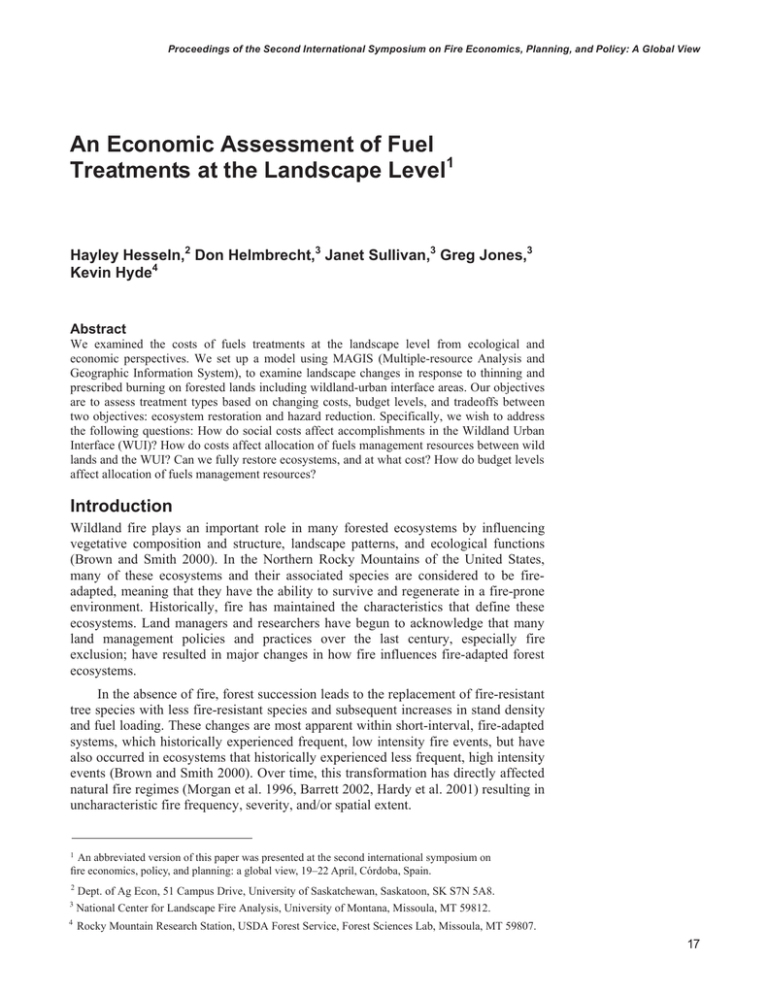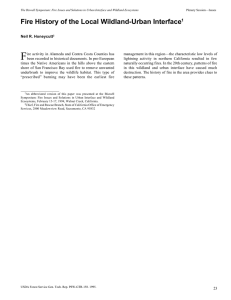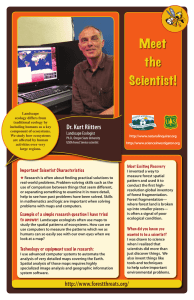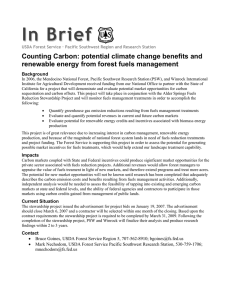Document 11233215
advertisement

Proceedings of the Second International Symposium on Fire Economics, Planning, and Policy: A Global View An Economic Assessment of Fuel Treatments at the Landscape Level1 Hayley Hesseln,2 Don Helmbrecht,3 Janet Sullivan,3 Greg Jones,3 Kevin Hyde4 Abstract We examined the costs of fuels treatments at the landscape level from ecological and economic perspectives. We set up a model using MAGIS (Multiple-resource Analysis and Geographic Information System), to examine landscape changes in response to thinning and prescribed burning on forested lands including wildland-urban interface areas. Our objectives are to assess treatment types based on changing costs, budget levels, and tradeoffs between two objectives: ecosystem restoration and hazard reduction. Specifically, we wish to address the following questions: How do social costs affect accomplishments in the Wildland Urban Interface (WUI)? How do costs affect allocation of fuels management resources between wild lands and the WUI? Can we fully restore ecosystems, and at what cost? How do budget levels affect allocation of fuels management resources? Introduction Wildland fire plays an important role in many forested ecosystems by influencing vegetative composition and structure, landscape patterns, and ecological functions (Brown and Smith 2000). In the Northern Rocky Mountains of the United States, many of these ecosystems and their associated species are considered to be fireadapted, meaning that they have the ability to survive and regenerate in a fire-prone environment. Historically, fire has maintained the characteristics that define these ecosystems. Land managers and researchers have begun to acknowledge that many land management policies and practices over the last century, especially fire exclusion; have resulted in major changes in how fire influences fire-adapted forest ecosystems. In the absence of fire, forest succession leads to the replacement of fire-resistant tree species with less fire-resistant species and subsequent increases in stand density and fuel loading. These changes are most apparent within short-interval, fire-adapted systems, which historically experienced frequent, low intensity fire events, but have also occurred in ecosystems that historically experienced less frequent, high intensity events (Brown and Smith 2000). Over time, this transformation has directly affected natural fire regimes (Morgan et al. 1996, Barrett 2002, Hardy et al. 2001) resulting in uncharacteristic fire frequency, severity, and/or spatial extent. 1 An abbreviated version of this paper was presented at the second international symposium on fire economics, policy, and planning: a global view, 19–22 April, Córdoba, Spain. 2 3 4 Dept. of Ag Econ, 51 Campus Drive, University of Saskatchewan, Saskatoon, SK S7N 5A8. National Center for Landscape Fire Analysis, University of Montana, Missoula, MT 59812. Rocky Mountain Research Station, USDA Forest Service, Forest Sciences Lab, Missoula, MT 59807. 17 USDA Forest Service Gen. Tech. Rep. PSW-GTR-xxx. xxxx. GENERAL TECHNICAL REPORT PSW-GTR-208 Session 3A—Economic Assessment of Fuels Treatments—Hesseln et al. Fire regimes refer to “the nature of fire occurring over long periods and the prominent immediate effects of fire that generally characterize an ecosystem” (Brown and Smith 2000). The fire process, however, is uniform in neither time nor space. The frequency, intensity, seasonality, extent, and other characteristics of fire, which collectively make up the fire regime, vary considerably across the landscape (Agee 1993) thus making it difficult to evaluate the impacts of altered fire regimes. Current wildland fire management acknowledges the importance of restoring the natural ecological role of fire. In fact, the 2001 Federal Wildland Fire Management Policy states as a guiding principle that “The role of wildland fire as an essential ecological process and natural change agent will be incorporated into the planning process.” (U.S. Department of the Interior and U.S. Department of Agriculture 2001). Information on the effects of restoration-based fuel treatment strategies can aid in the success of future fuel management programs. The objective of this research is to use a modeling approach to analyze the impacts of alternative fuels treatment strategies. We will combine financial, economic, and social information in a decision-making framework to evaluate the costs of alternative treatments for two objectives; (1) hazardous fuels reduction in the wildland-urban interface, and (2) restoration in fire-adapted ecosystems. These objectives are directly applicable to modeling and are consistent with the National Fire Plan. Two goals of the NFP are 1) hazardous fuels reduction and 2) restoration in fire-adapted ecosystems. Our objectives will be tied to mapping Communities at Risk (CAR) and Ecosystems at Risk (EAR). We next provide our methodology and expectations followed by a discussion of potential findings. Methodology We use the optimization model MAGIS (Multi-resource Analysis and Geographic Information System) to analyze the effectiveness of fuel treatments at the landscape scale (Jones et al. 1999, Chew et al. 2000) for the Bitterroot Mountains in western Montana. “MAGIS uses optimization to select the spatial arrangement and timing of treatments that fits user-determined objectives and constraints. MAGIS users can also specify the location and timing for specific treatments to test ‘what-if’ scenarios.” (USDA Forest Service 2003). The model integrates ecological, social, and economic information which provides the basis from which to schedule treatments at the landscape level. MAGIS also provides as output the ecological effects and economic outcomes. Activities that can be modeled include a wide variety of silvicultural methods such as those geared toward mechanical fuels treatments and prescribed burning. Our study site is located along the Montana/Idaho border and is approximately 96 km long. The Bitterroot Front was chosen as the study area because it is composed of approximately 105,208 hectares of forested land that represents a variety of forest types and includes a substantial wildland-urban interface component. 18 We are using the Northern Region Cohesive Strategy Team's risk assessments (i.e., communities at risk (CAR) and ecosystems at risk (EAR)) to define objective functions in MAGIS (USDA Forest Service 2003). Specifically, we will integrate the risk rule sets into MAGIS so that the risk attribute changes dynamically with changes in vegetation over time. Vegetative states are modeled using succession and are based USDA Forest Service Gen. Tech. Rep. PSW-GTR-xxx. xxxx. Proceedings of the Second International Symposium on Fire Economics, Planning, and Policy: A Global View Session 3A.—Economic Assessment of Fuels Treatments—Hesseln et al. on the Region 1 west side zones, also used in SIMPPLLE (SIMulating Processes and Patterns at Landscape scaLEs5) Definitions for EAR and CAR are presented below as they are defined on the Internet.6 Ecosystems at Risk (EAR) Estimating the relative risk of ecosystems from wildland fire requires an assessment of the likelihood of fire occurrence; and likely fire effects to an ecosystem should it catch fire. A spatial of ignition probability was derived from 20-years of fire data by interpolating between known fire locations and counting the of fires within a 4-km2 neighborhood. Ignitions were then classified [into]5 classes ranging from low to high. Fire-regime condition class is an index of the of the current condition from the historical fire regime. Consequently it is derived from the historical fire regime and an estimate of the fire severity if a fire occurred. Fire-regime condition class is as a proxy for the probability of severe fire effects (e.g., the of key ecosystem components - soil, vegetation structure, species; alteration of key ecosystem processes - nutrient cycles, hydrologic regimes). Consequently, fire-regime condition class is an index of risk to the many components (e.g., water quality, fish status, wildlife habitats, etc.). Ignition probability was integrated with fire-regime condition class to derive ecosystems-at-risk; the likelihood that components will be lost if a wildland fire occurred. Communities at Risk (CAR) The top priority of the National Fire Plan, FS-Cohesive Strategy and the Western Governors' 10-Year Comprehensive Strategy Plan is undoubtedly to reduce the threats of wildland fire to wildland-urban interface. The relative risk of communities to fire requires consideration of 3 factors: (1) the of fire occurrence; (2) the likely fire behavior should a fire occur; and (3) human settlement patterns. Therefore, the ignition probability, fire behavior, and population density spatial themes were to estimate the relative risk of the wildland-urban interface wildland fires. We will use EAR and CAR as the basis for our models so that our assumptions and sensitivity analysis will be based on realistic fire management goals that are consistent with the National Fire Plan. Research Goals Our primary goal is to map a landscape in the Bitterroot Valley that can be manipulated for use by MAGIS to (i) minimize costs, or (ii) maximize acres treated for given sets of constraints including timing, budget levels, and acres treated. Holding other things equal we explore the following questions: How do targeted temporal goals affect allocation and cost? How does the budget affect accomplishments and allocation between two objectives? How do targeted acres affect costs and objectives? 5 6 http://www.fs.fed.us/rm/missoula/4151/SIMPPLLE http://www.fs.fed.us/r1/cohesive_strategy/sitemapfr.htm. 19 GENERAL TECHNICAL REPORT PSW-GTR-208 Session 3A—Economic Assessment of Fuels Treatments—Hesseln et al. To address our research questions, we will develop a series of scenarios and decision rules. Potential rules may include the following: x Treat only WUI acres (or prioritize), x Treat only non-WUI acres (or prioritize), x Treat all acres without preference, x Treat acres with varying budget levels, x Change treatment costs for stated scenarios. Treatment methods will be predicated on condition class. For example, mechanical treatment methods must first be used for ecosystems classed as fireregime condition class three (CC3) prior to Prescribed burning. We will assess various fuels treatment methods including prescribed burning, mechanical fuels treatments and a combination of the two. We provide an example of selected potential treatments available and treatment scenarios that may be used for the simulation. While these are not our final choices, they do give an indication of our assessment opportunities. Below is a table of potential treatment types. Table 1ʊ Potential Treatment Types. Activity Treatment Goals Underburn Reduce understory fuels Pre-commercial thin and Mechanical thinning to remove ladder fuels, then burn underburn to reduce fuels from slash and other understory vegetation Commercial thin Remove mostly smaller diameter material and reduce ladder fuels. Improvement cut Remove undesirable species (regardless of size) in addition to smaller size components Shelterwood Seedcut Regeneration cut removes 60% of the overstory, leaving a residual stand in large trees of desirable species. Understory removed. Based on the treatment types presented above, we will develop scenarios with explicit rules. We will begin with a No Action alternative and take baseline measures. Our objective will be to minimize EAR adding successively more constraints. We will repeat these iterations to minimize CAR as well and combine information to develop a final solution for each scenario. Table 2ʊ Potential Scenarios that minimize EAR Scenario Activity Comments 1. No Action No activity Develop baseline indicator using CAR, EAR, Condition Class, or combination. 2. WUI objective 3. No objective priority 4. Ecosystem restoration objective 20 Treat only WUI acres Treat all acres Treat non-WUI areas (excluding wilderness) Develop treatments based on budget restraints, acreage constraints, and treatment constraints. Develop treatments based on budget restraints, acreage constraints, and treatment constraints. Develop treatments based on budget restraints, acreage constraints, and treatment constraints. USDA Forest Service Gen. Tech. Rep. PSW-GTR-xxx. xxxx. Proceedings of the Second International Symposium on Fire Economics, Planning, and Policy: A Global View Session 3A—Economic Assessment of Fuels Treatments—Hesseln et al. In each case, we will explore similar objectives based on maximizing present net value (PNV), minimizing cost, or treating a specified number of acres. Discussion This research will provide fire and forest managers with much needed information regarding the feasibility of fuels treatment methods over time. Using an array of treatment scenarios we will be able to assess changes in costs and accomplishments, and to identify the potential success of fire management programs aimed to reduce risk in the wildland-urban interface, or to restore ecosystems, or some combination. Our findings will also be useful to policy makers for guidelines to developing realistic fire management policy regarding annual accomplishments and outcomes. References Agee, J.K. 1993. Fire ecology of Pacific Northwest forests. Island Press: Washington, D.C. 493 pp. Arno, S.F. 2000. Chapter five: Fire in Western forest ecosystems. In: Brown, J.K.; Smith J.K., eds. 2000. Wildland fire in ecosystems: effects of fire on flora. Gen. Tech. Rep. RMRSGTR-42-vol. 2. Ogden, UT: U.S. Department of Agriculture, Forest Service, Rocky Mountain Research Station: 97-120. Arno, S.F.; Petersen, T.D. 1983. Variation in estimates of fire intervals: A closer look at fire history on the Bitterroot National Forest. Research Paper INT-301. Ogden, UT: U.S. Department of Agriculture, Forest Service, Intermountain Forest and Range Experiment Station. 8 p. Arno, S.F.; Scott, J.H.; Hartwell, M.G. 1995. Age-class structure of old growth ponderosa pine/Douglas-fir stands and its relationship to fire history. Research paper INT-RP-481. Ogden, UT: U.S. Department of Agriculture, Forest Service, Intermountain Research Station. 25 p. Baker, W.L. 1993. Spatially heterogeneous multi-scale response of landscapes to fire suppression. Oikos 66, 66-71. Brown, J.K.; Arno, S.F.; Barrett S.W.; Menakis, J.P. 1994. Comparing the prescribed natural fire program with presettlement fires in the Selway-Bitterroot Wilderness. International Journal of Wildland Fire 4, 157-168. Chew, J.D. 1995. Development of a system for simulating vegetative patterns and processes at landscape scales. Ph.D. dissertation. University of Montana, Missoula, MT. 182 p. Chew, J.D.; Moeller, K.; Stalling C.; Bella; E.M.; Ahl, R.S. 2002. User’s Guide for SIMPPLLE, version 2.2. Proposed Gen. Tech. Rep. RMRS-GTR-xxx. U.S. Department of Agriculture, Forest Service, Rocky Mountain Research Station. 222 p. ESRI Inc. 2001. ArcGIS, version 8.2. Environmental Systems Research Institute, Inc. Redlands, CA. USA. Hartwell, M.G. 1997. Comparing historic and present conifer species compositions and structures on forested landscapes of the Bitterroot Front. Jones, J. G.; Chew, J. D; Zuuring, H R. 1999. Applying simulation and optimization to plan fuel treatments at landscape scales. In: Gonzalez-Caban, Armando; Omi, Philip N., tech. coords. Gen. Tech. Rep. PSW-GTR-173. Proceedings of the Symposium on Fire Economics Planning, and Policy: Bottom Lines; 1999 April 5-9; San Diego, CA. 21 GENERAL TECHNICAL REPORT PSW-GTR-208 Session 3A—Economic Assessment of Fuels Treatments—Hesseln et al. Albany, CA: U.S. Department of Agriculture, Forest Service, Pacific Southwest Research Station: 229-336. Jones, J.L.; Barrett S.W.; Berglund, D. 2002. Modeling historical and current fire regimes for major vegetation types in northern Idaho and western Montana: A first approximation. Office report on file, Planning Division, USDA Forest Service, Flathead National Forest, Kalispell, MT. 27 p. Keifer, M.; Caprio, A.C.; Lineback, P.; Folger, K. 2000. Incorporating a GIS model of ecological need into fire management planning. Pages 122-129 in Neuenschwander, L.G. and Ryan, K.C., technical eds. Proceedings of the Joint Fire Science Conference and Workshop, Volume 1, June 15-17 1999, Boise, ID. Landres, P.B.; Morgan, P.; Swanson, F.J. 1999. Overview of the use of natural variability concepts in managing ecological systems. Ecological Applications 9(4), 1179-1188. Long, D.G. 1998. Mapping historical fire regimes in northern Rocky Mountain landscapes. Thesis. University of Idaho, Moscow, Idaho. 63 p. Miller, C.; Landres, P.B.; Alaback, P.B. 2000. Evaluating risks and benefits of wildland fire at landscape scales. Pages 78-87 in Neuenschwander, L.G. and Ryan, K.C., technical eds. Proceedings of the Joint Fire Science Conference and Workshop, Volume 1, June 15-17 1999, Boise, ID. Sampson, N.; Atkinson, D.; Lewis, J. eds. 2000. Mapping wildfire hazards and risks. The Haworth Press, Inc. Schmidt, K.M.; Menakis, J.P.; Hardy, C.C.; Hann, W.J.; Bunnell, D.L. 2002. Development of coarse-scale spatial data for wildland fire and fuel management. Gen. Tech. Rep. RMRS-GTR-87. Fort Collins, CO: U.S. Department of Agriculture, Forest Service, Rocky Mountain Research Station, 41 p. + CD. U.S. Department of Agriculture, Forest Service, Northern Region Cohesive Strategy Team. 2003. Fire management plan. http://www.fs.fed.us/r1/cohesive_strategy/contactfr.htm. Flathead National Forest, 1935 3rd Ave. East. Kalispell, MT 59901. U.S. Department of Agriculture, Forest Service, Rocky Mountain Research Station, Fire Sciences Laboratory (2002, September). Fire Effects Information System, [Online]. Available: http://www.fs.fed.us/database/feis/ [Accessed September 2002]. U.S. Department of Agriculture, Forest Service, Rocky Mountain Research Station. 2003. Software and land management planning. http://www.fs.fed.us/rm/econ/magis/ accessed February 25, 2004. U.S. Department of the Interior and U.S. Department of Agriculture. 2001. Review and update of the 1995 federal wildland fire management policy. Bureau of Land Management, Boise, ID. WSAL. 2000. FireRisk: A fuels, fire, fire regime database. Version 1.0. Prepared for the USDA Forest Service, Northern Region by Wildlife Spatial Analysis Lab, Montana Cooperative Wildlife Research Unit, The University of Montana, Missoula, MT 59812. 22


